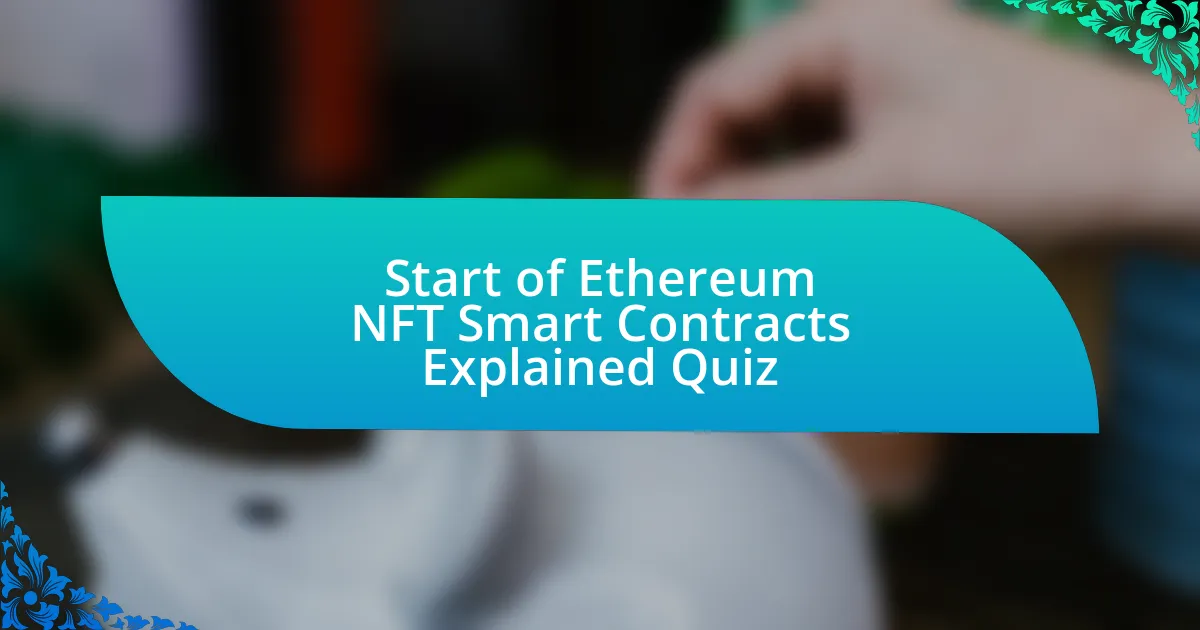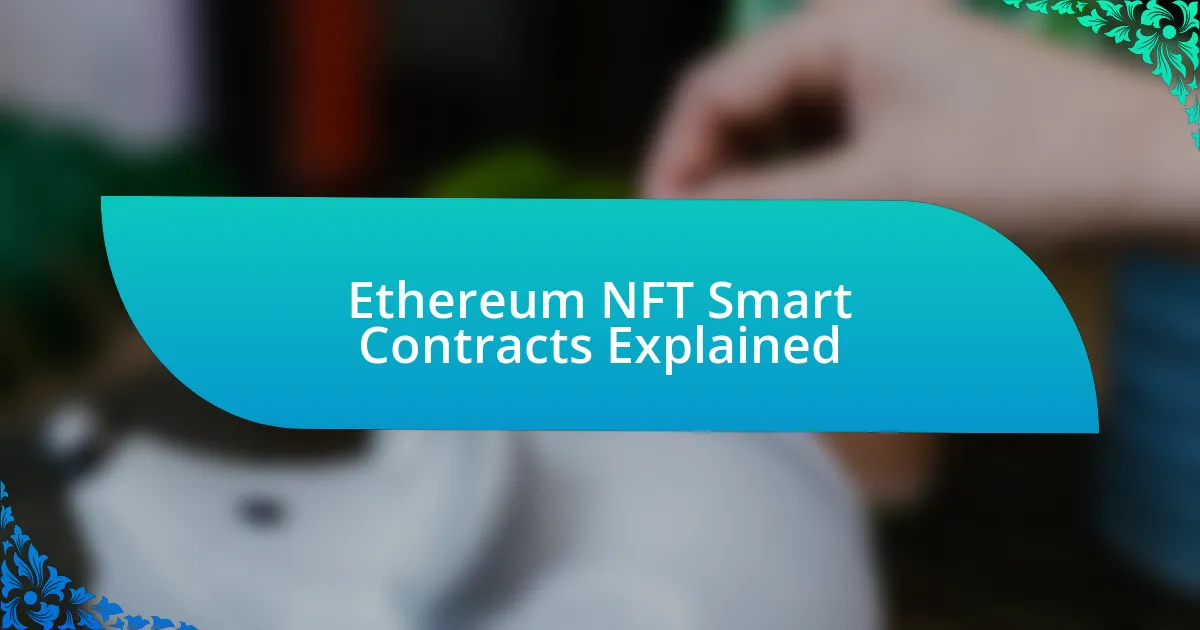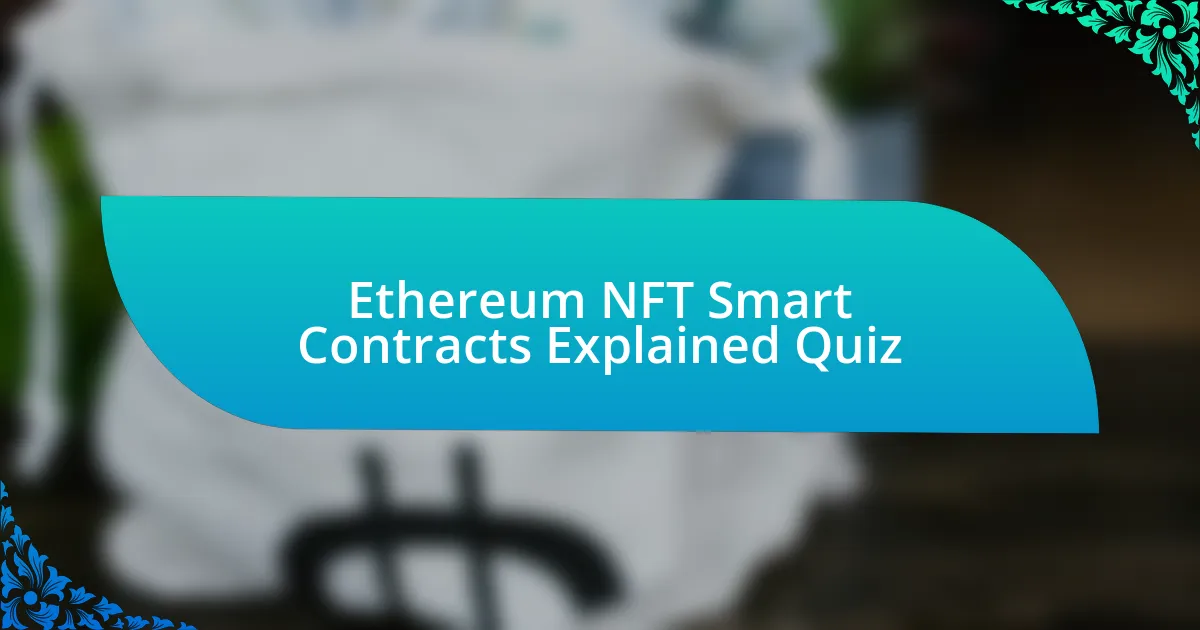
Start of Ethereum NFT Smart Contracts Explained Quiz
1. What is the primary purpose of a smart contract for NFTs on Ethereum?
- To mine new Ethereum coins for profit.
- To create cryptocurrencies for trading on exchanges.
- To automate NFT transactions and establish ownership records.
- To enable physical asset transactions in the real world.
2. Which Ethereum standard is specifically designed for non-fungible tokens?
- ERC-20
- ERC-721
- ERC-777
- ERC-1155
3. How does the `approve` function work in an NFT smart contract?
- The `approve` function transfers all NFTs from the owner to a single address.
- The `approve` function allows a designated address to transfer a specific NFT from the owner`s account.
- The `approve` function mints new NFTs and assigns them to the caller.
- The `approve` function can change the metadata of an existing NFT.
4. What are gas fees and why are they important for NFT smart contracts?
- Gas fees are rewards for NFT creators from sales of their art.
- Gas fees are transaction costs paid in Ethereum for executing smart contracts.
- Gas fees are fees for hosting NFT websites on servers.
- Gas fees are taxes imposed by governments on digital assets.
5. What method is used to mint new NFTs in a smart contract?
- Minting
- Forging
- Fabricating
- Printing
6. Can NFT smart contracts have variable royalty percentages?
- Yes, NFT smart contracts only allow fixed royalty percentages.
- No, NFT smart contracts cannot have any royalties.
- Yes, NFT smart contracts can have variable royalty percentages.
- No, NFT smart contracts do not support royalty features.
7. What determines the uniqueness of an NFT?
- The owner`s wallet address
- The type of blockchain used
- The unique token ID of the NFT
- The creation date of the NFT
8. How does the `setApprovalForAll` function enhance NFT ownership transfer?
- It creates a new NFT and assigns ownership.
- It allows easy bulk approval of addresses to manage NFTs.
- It updates the NFT metadata for all owners.
- It restricts transfers to only one specified wallet.
9. What are the implications of owning an NFT in terms of intellectual property?
- Owning an NFT may grant certain intellectual property rights, depending on the agreement between the creator and the buyer.
- Owning an NFT prohibits the buyer from displaying the art in any form.
- Owning an NFT means the buyer can reproduce the art for commercial purposes without permission.
- Owning an NFT always includes full copyright transfer to the buyer.
10. How can visibility modifiers affect functions in an NFT smart contract?
- They can automatically generate transactions without user input.
- They can restrict or allow access to certain functions based on user roles.
- They can enhance the performance of the functions by reducing execution time.
- They can eliminate all potential errors in function executions.
11. What mechanisms protect users from unauthorized NFT sales in smart contracts?
- Automatic resale via marketplace integration.
- Ownership verification through multi-signature wallets.
- NFT price auctioning by user preference.
- Randomized distribution of NFTs to buyers.
12. How do developers test NFT smart contracts before deploying them?
- Sending to a live wallet
- Testing on testnet environments
- Deploying on the mainnet
- Creating a physical copy
13. What role does off-chain data play in NFT smart contracts?
- Off-chain data provides essential information for NFT smart contracts beyond what`s stored on the blockchain.
- Off-chain data is used to enhance the aesthetic quality of NFTs in the marketplace.
- Off-chain data ensures the immutability of NFT ownership records by storing them off-chain.
- Off-chain data allows for faster transaction speeds by removing blockchain verification.
14. How can NFT metadata be linked to external resources?
- By manually updating the metadata in each blockchain transaction.
- Using a function that links to a social media profile.
- Through embedding images directly in the smart contract code.
- By using a tokenURI function that points to external links.
15. What is the significance of the `burn` function in NFT smart contracts?
- It allows for the destruction of NFTs to reduce supply.
- It updates metadata for existing NFTs.
- It facilitates the transfer of NFTs between users.
- It enables the creation of new NFTs.
16. How might a DAO (Decentralized Autonomous Organization) use NFT smart contracts?
- To mine cryptocurrencies at a higher rate.
- To manage voting rights and governance within the organization.
- To facilitate traditional banking transactions.
- To create physical art pieces from digital files.
17. What security vulnerabilities should be considered when developing NFT smart contracts?
- Centralized access control
- Reentrancy attacks
- Gas limit fluctuations
- Token burn requests
18. How do NFT marketplaces leverage Ethereum smart contracts for transactions?
- Smart contracts create physical copies of NFTs for users.
- Smart contracts require manual validation of every NFT transaction.
- Smart contracts randomly distribute NFTs without user interaction.
- Smart contracts automate the sale and transfer of NFTs through pre-defined terms.
19. What difference does the `getter` function make in NFT smart contracts?
- The `getter` function deletes token records in NFT smart contracts.
- The `getter` function serves no purpose in NFT smart contracts.
- The `getter` function allows access to specific token properties in NFT smart contracts.
- The `getter` function creates new NFTs in smart contracts.
20. How can smart contracts ensure fair auction processes for NFTs?
- Smart contracts rely on third parties to conduct auctions and enforce rules.
- Smart contracts automatically execute rules and terms, ensuring transparency and fairness throughout the auction process.
- Smart contracts eliminate the need for bids and set fixed prices for all NFTs.
- Smart contracts require manual intervention to finalize auctions and verify bids.
21. What is the function of event logging in NFT smart contracts?
- To enhance the visual aesthetics of NFTs.
- To increase the rarity of NFTs.
- To limit the number of tokens created.
- To track events related to NFT transactions.
22. How can NFT smart contracts create social impact through their functionalities?
- NFT smart contracts can allocate a percentage of sales to charity organizations.
- NFT smart contracts can track physical assets like real estate titles indiscriminately.
- NFT smart contracts can only function within the gaming industry without wider applications.
- NFT smart contracts can guarantee profits for all creators by regulating the market.
23. What is the importance of testing different scenarios in NFT contract development?
- It eliminates the need for a blockchain when creating NFTs.
- It helps identify potential vulnerabilities or issues before deployment.
- It prevents users from trading NFTs on different platforms.
- It ensures all NFTs are identical in appearance and function.
24. How do NFT smart contracts handle multiple ownership models?
- NFT smart contracts use a single ownership model that cannot be altered after deployment.
- NFT smart contracts implement multiple ownership by creating duplicate tokens for each owner.
- NFT smart contracts can define multiple ownership models using mappings and functions to track shares.
- NFT smart contracts allow for multiple ownership by linking all owners to a single wallet address.
25. What considerations are there for gas efficiency in NFT transactions?
- Fixed prices for all transactions regardless of network state
- Unlimited gas fees without considerations for optimization
- Less congestion and optimized gas fees through batch transactions
- Higher minting fees and transaction delays
26. How do NFT smart contracts contribute to the provenance of digital art?
- They create digital art by generating images or designs.
- They determine the rarity of physical art pieces.
- They ensure verifiable ownership and history of digital art through immutable records.
- They only manage the sale price of digital art assets.
27. What is the role of oracles in expanding NFT capabilities beyond Ethereum?
- Oracles provide real-world data to NFT projects, enabling them to interact with multiple blockchains seamlessly.
- Oracles restrict NFT functions solely to Ethereum smart contracts.
- Oracles only validate the uniqueness of NFTs on Ethereum.
- Oracles are exclusively used for creating new NFTs on Ethereum.
28. How can NFT smart contracts define time-limited access to digital content?
- By ensuring all users can access the content permanently.
- By randomly changing the ownership of the NFT.
- By setting expiration dates on access through the contract.
- By creating multiple copies of the digital content.
29. How do platforms ensure interoperability of NFTs across different blockchains?
- By locking NFTs in a central exchange for trading.
- By requiring users to visit multiple platforms for NFT access.
- By converting NFTs into ERC-20 tokens for compatibility.
- Using cross-chain bridges and protocols to enable NFT transfers.
30. What strategies can be used to mitigate against lost or stolen NFTs?
- Use a secure wallet with two-factor authentication.
- Avoid monitoring your NFT assets.
- Share wallet passwords with friends.
- Store NFTs in a physical location.

Quiz Completed Successfully!
Congratulations on completing the quiz on Ethereum NFT smart contracts! We hope you found the experience enjoyable and enriching. Testing your knowledge helps solidify what you’ve learned. It can also reveal areas where you might want to delve deeper.
Throughout the quiz, you likely picked up valuable insights about how smart contracts function in the Ethereum ecosystem. Understanding the mechanics behind NFTs and their contracts is crucial for anyone interested in blockchain technology. You may now have a clearer idea of how these elements interplay to create unique digital assets.
If you’re eager to expand your understanding further, we invite you to check out the next section on this page. It offers a deeper look into Ethereum NFT smart contracts. You’ll find comprehensive information that can enhance your knowledge and help you stay current in this rapidly evolving field.

Ethereum NFT Smart Contracts Explained
What are Smart Contracts on Ethereum?
Smart contracts on Ethereum are self-executing contracts with the terms of the agreement directly written into code. They run on the Ethereum blockchain, ensuring transparency and security. When predefined conditions are met, the contract automatically executes actions, eliminating the need for intermediaries. This technology underpins many decentralized applications and operates on Ethereum’s decentralized network.
Understanding NFTs (Non-Fungible Tokens)
NFTs, or Non-Fungible Tokens, are unique digital assets verified using blockchain technology. Unlike cryptocurrencies, which are fungible and interchangeable, NFTs represent ownership of distinct items, such as artwork or music. Each NFT has unique metadata and attributes, making it one of a kind. They are primarily traded on the Ethereum blockchain, contributing to its growing ecosystem.
How Ethereum Smart Contracts Facilitate NFTs
Ethereum smart contracts play a crucial role in creating and managing NFTs. They define the rules for minting, buying, and transferring these tokens. When an NFT is created, a smart contract records its unique attributes on the Ethereum blockchain. This ensures authenticity and creates a verifiable ownership record. The use of smart contracts makes NFT transactions automated and trustless, enhancing security in the marketplace.
Common Standards for Ethereum NFTs
Ethereum NFTs typically adhere to specific standards like ERC-721 and ERC-1155. The ERC-721 standard allows for the creation of unique NFTs, enabling each token to have distinct characteristics. On the other hand, ERC-1155 supports both fungible and non-fungible tokens within a single contract. These standards facilitate compatibility with various marketplaces, enhancing usability and accessibility for creators and collectors alike.
Potential Use Cases of Ethereum NFT Smart Contracts
Ethereum NFT smart contracts have diverse applications across several industries. Artists use them to tokenize and sell digital artwork while maintaining ownership rights. The gaming industry benefits from NFTs that represent in-game assets, allowing players to buy, sell, or trade items. Additionally, NFTs are utilized in real estate for tokenizing properties, simplifying transactions and enhancing security. These use cases demonstrate the versatility and potential impact of Ethereum NFT smart contracts.
What are Ethereum NFT Smart Contracts?
Ethereum NFT smart contracts are self-executing contracts with the terms of the agreement directly written into code. These contracts facilitate the creation, transfer, and management of non-fungible tokens (NFTs) on the Ethereum blockchain. NFTs represent unique digital assets, such as art, music, or virtual real estate, and the smart contracts ensure ownership and provenance by recording transactions securely on the blockchain.
How do Ethereum NFT Smart Contracts work?
Ethereum NFT smart contracts work by employing the ERC-721 standard for NFTs, enabling the creation of unique digital tokens. When an NFT is created, a smart contract stores essential information like ownership details, token metadata, and transaction history. The smart contract performs operations such as transfers or sales automatically when predefined conditions are met, ensuring trust and transparency between parties involved in the transaction.
Where are Ethereum NFT Smart Contracts deployed?
Ethereum NFT smart contracts are deployed on the Ethereum blockchain, which is a decentralized network that allows for smart contract functionality. When a smart contract is deployed, it becomes part of the blockchain’s immutable ledger, ensuring that all interactions with the contract are transparent and verifiable by any user on the network.
When were Ethereum NFT Smart Contracts introduced?
Ethereum NFT smart contracts were effectively introduced with the release of the ERC-721 token standard in late 2017. This standard was established to allow developers to create unique digital items, leading to the proliferation of NFTs in various digital art and gaming markets. The first major NFT projects, such as CryptoKitties, gained popularity shortly after the introduction of ERC-721.
Who creates Ethereum NFT Smart Contracts?
Ethereum NFT smart contracts are typically created by developers with knowledge of blockchain technology and programming languages like Solidity. Artists, creators, and companies may also engage developers to create customized smart contracts for their specific NFT projects. These contracts are essential for managing the unique attributes and transactions of NFTs throughout their lifecycle.

